Lambs & Sheep
Sheep are intelligent animals, with remarkable memory and recognition skills, they build friendships and show loyalty to one another.
Lambs & Sheep
Sheep are intelligent animals, with remarkable memory and recognition skills, they build friendships and show loyalty to one another.
Sheep are sentient beings, they are playful, curious, and loving.
A 2009 study published in Animal Welfare found that sheep experience a whole range of feelings, from fear to anger, despair, boredom and happiness.
Over 30 million lambs and sheep are slaughtered every year in Australia.
‘Dual-Purpose’ Breeds
Sheep are farmed and exploited for both their wool and flesh, sold as lamb and mutton meat. The wool and meat industries are intrinsically linked.
Meat and Livestock Australia, The Woolmark Company and Australian Wool Innovation all state that the large majority of sheep breeds are ‘dual-purpose’ as they can be exploited both for their wool and meat. This is even the case for ‘wool sheep’ like Merinos.
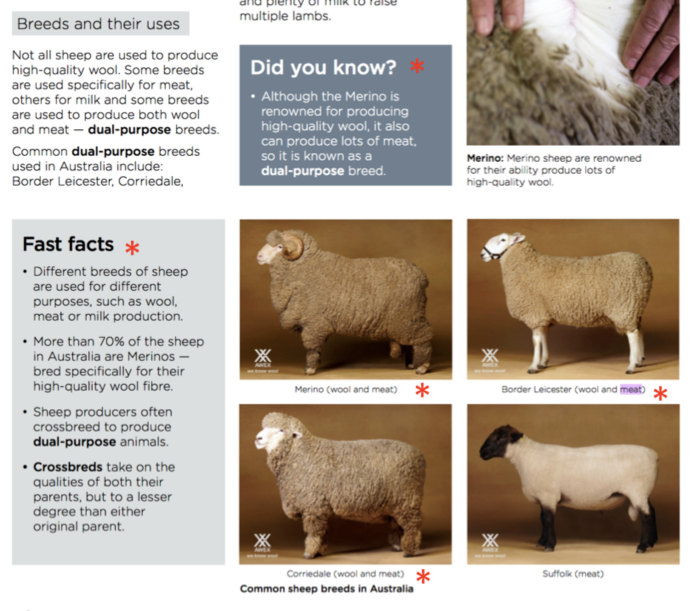
Slaughter: Lambs
The majority of sheep killed in Australia are lambs, slaughtered around 6 – 8 months of age. Sheep can naturally live up to 20 years, with a typical lifespan of 10-12 years.
Every year an average of 22.72 million lambs are slaughtered.
These lambs are slaughtered for their meat. Because they are still babies, their flesh is more tender and considered better to eat. It is also more profitable for farmers to be responsible for the care of sheep for a shorter period of time.
Farmers often can make an extra profit from shearing lambs before slaughter, and selling their wool. This is one of the reasons that the wool and meat industries are interconnected.
From the size and appearance of the lambs below, it is highly likely these lambs will soon be slaughtered. Recently shorn and huddling against a tree to keep as warm as possible in the near freezing cold.
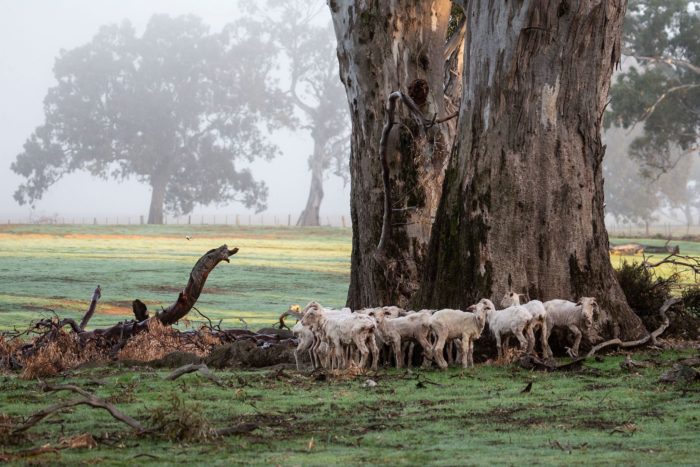
Slaughter: Sheep
Sheep that are ‘bred for wool’ are kept alive for longer than those slaughtered for lamb meat. These sheep are routinely shorn every year, until their wool production decreases and is less valuable.
Sheep are ‘cast for age’ and sent to be slaughtered at 5 – 6 years old when their wool becomes more brittle, and of a lesser quality and quantity. These sheep are still young, and would naturally live for 10-12 years.
Sheep that are slaughtered when they no longer profit the wool industry have their flesh sold as mutton meat.
Mutton is not as expensive as lamb, as the animal is older: ‘The market price fluctuates, but say lamb is being sold for $7.50 a kilo, mutton might be around half that price or less.’ – Feather and Bone butcher
Mutton meat comes from sheep that have been bred for wool, and can be considered a co-product of the industry. If sheep are not being exploited for their wool, it would not be profitable for farmers to keep them alive for longer than the 6 – 8 months lambs are slaughtered at.
Every year an average of 8.4 million fully grown sheep are slaughtered. These sheep will, mostly, go through sale yards and be sold to the highest bidder.
Live Export
Mutton is not a hugely popular meat in Australia, and so many of the sheep that are ‘cast for age’ in the wool industry are those who are sold into the live export trade. In 2018, 973,651 sheep were exported alive from Australia, to be slaughtered overseas. 5,982 of these sheep died on their way there, according to Government reporting.
Investigations into live export ships have shown that they are overcrowded, with sheep often unable to move, or able to access food and water. Sheep on the long voyages have been documented lying stuck in a ‘soup’ of weeks worth of urine and faeces, and even being cooked alive in the heat.

Winter Lambing
Additionally, every year in Australia around 10 to 15 million newborn lambs die of starvation, neglect and exposure within 48 hours of birth due largely to the practice of winter lambing.
Farmers practice winter lambing in order to produce the highest number of lambs at the lowest cost. Sheep are impregnated so that they give birth in winter months and their babies are weaned in spring, the times that pastures are most fertile. This means the mothers have richer feed in winter, and the surviving lambs grow fatter more quickly in springtime. The result of this is that lambs are born in the harsh conditions of winter, and up to a quarter of them do not survive their first few days.
In most cases, sheep and their babies are not provided sufficient shelter from the wind, rain and frost, or protection from predators, resulting in massive mortality during the harsh winter months. For farmers, the millions of deaths are an acceptable consequence of reduced feed costs and heavier spring lambs.
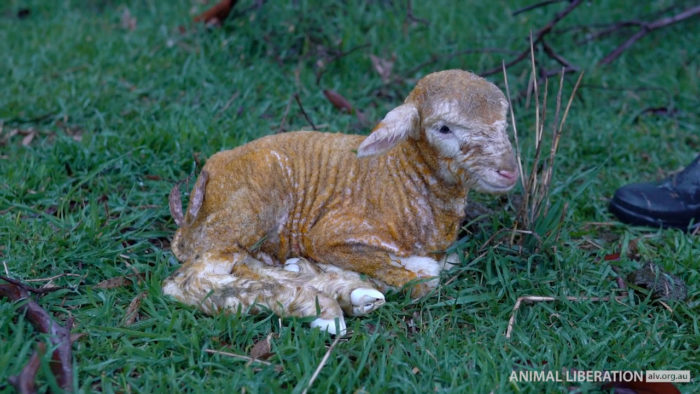
Lambing Selective Breeding: Lambing and Mothers
As the result of years of selective breeding, farmed sheep regularly give birth to twins and triplets.
These multiple births regularly involve complications. Mother ewes can exhaust themselves birthing multiple lambs and become ‘downed’, they will sometimes prolapse and die, leaving orphaned lambs.
Multiple births leads to babies being born weaker, smaller, and therefore with a lower chance of survival. This is especially the case with triplets, who are being seen more often by rescuers.
More lambs are also rejected by their mothers, as they choose the strongest baby in hopes one may live – an already tough challenge for mothers birthing in winter. Mother ewes are often exhausted and in poor condition themselves, sometimes needing to prioritise keeping themselves alive. These factors all lead to a high number of deaths.

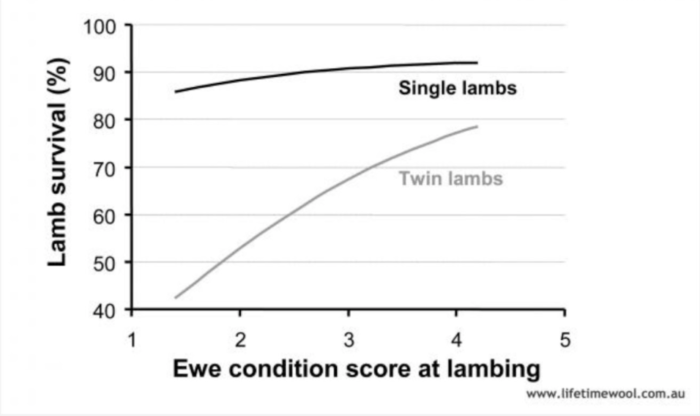
When there are so many babies being born, on farms with hundreds or thousands of sheep, it is not worth the financial effort for the farmer to find and care for these babies and suffering mothers. Losses in lambing season are factored into the finances of the season.
Agriculture Victoria recommends orphaned and stray lambs be ‘destroyed humanely’, by a ‘heavy blow to the back of the head… followed immediately by bleeding out’. Essentially, it is recommended babies be hit in the head with something hard, perhaps a rock or a hammer, and then have their throat slit open.
While this is horrific, Animal Liberation Victoria more commonly finds that lambs are abandoned, left to slowly die, as this means less work for farmers.
Lambing Deaths Lead To Predation
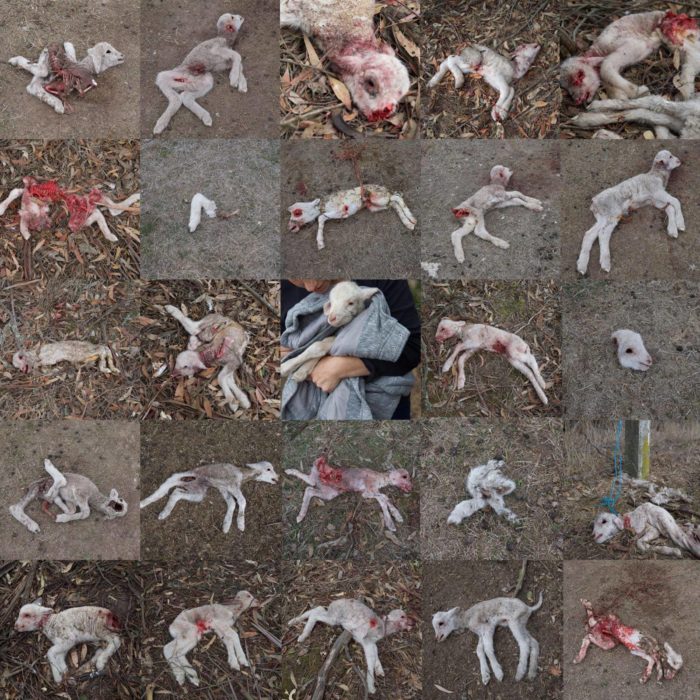
When flocks are not monitored regularly enough, as often is the case, dead lambs are left amongst live sheep and lambs. Their bodies lure foxes and birds of prey closer to the flock, and this endangers those who may already be vulnerable due to difficult births, downing, hypothermia, starvation, neglect, or orphaning.
Downed ewe mothers and struggling babies are then more likely to be preyed on and attacked, suffering through this while still alive, yet unable to protect themselves due to their poor condition.
Farmers have a responsibility to care for those they force into the world for the sake of profit – this cycle is not natural.
Standard Practice: Tail Docking
Sheep are subjected to routine mutilations, such as tail docking. This is why you almost never see a sheep with their tail.
From Agriculture Victoria: ‘Acceptable methods of tail docking, without anaesthesia, are: cutting with a sharp knife; applying rubber rings according to the manufacturer’s recommendation, or using a gas flame heated scarring iron…’
The Responsible Wool Standard, a type of so called ‘animal welfare’ accreditation which, as of May 2019, 13 Australian organisations are certified with, recommends a heated scarring iron for tail docking. A heated scarring iron, also described by RWS as a ‘hot knife’, sears through the flesh and bone with its intense heat, severing the tail.
Tail docking is done so as to prevent fly strike, a myiasis condition where domesticated sheep are infected by fly species which are a type of external parasite to sheep. However, this is not not a necessary procedure, and sanctuaries with rescues animals protect their sheep from fly strike by far less invasive care techniques. Kind methods of fly strike prevention are far more time consuming and therefore costly, which is not considered ‘good business’ in the sheep industry.
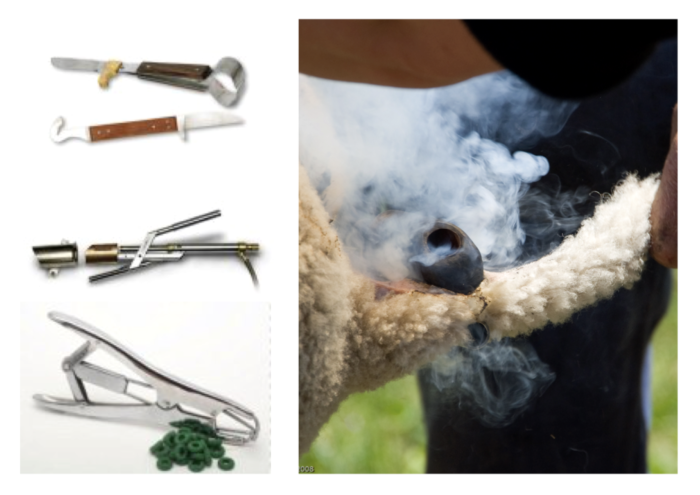
Standard Practice: Castration
Castration of male lambs is done in much the same way as tail docking. Agriculture Victoria state:
‘Acceptable methods of castrating male lambs without anaesthesia are by:
(a) cutting: the lamb should be properly restrained and the knife (cutting instrument) should be kept clean and sharp; good post-operative drainage of the wound is required;
(b) rubber rings applied according to the manufacturer’s recommendation’
The Responsible Wool Standard recommends castration be performed on babies between 24 hours and 8 weeks old. RWS recommends castration by cutting circulation to the testicles by rubber banding, or by an ’emasculator’ which is a tool that crushes and severs the spermatic cord.
Castration is performed on male lambs, as farmers want to ensure only the ewes and rams with the best, most profitable genes are bred, and only at specific times of the year which are cost effective.
‘We know that castration will cause pain, regardless of which castration method is used or the age…’
– A Greener World, Animal Welfare Approved
Technical Paper
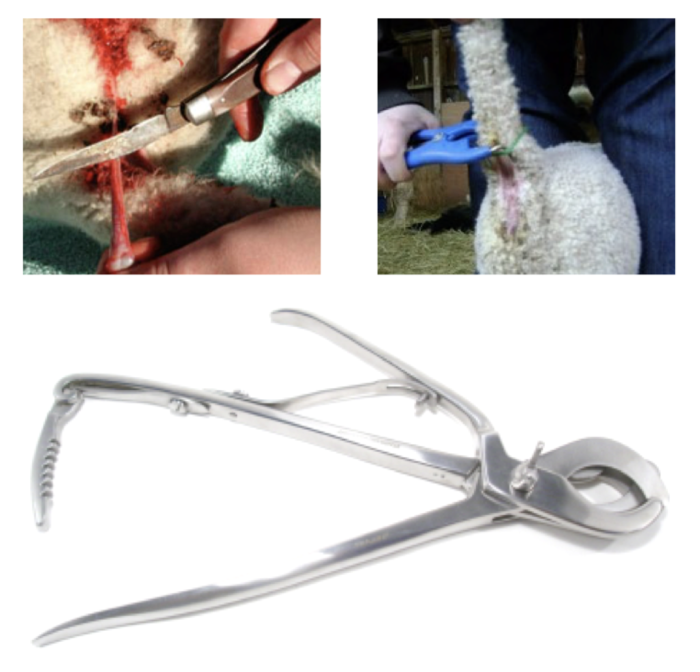
Standard Practice: Mulesing
Mulesing is the practice of slicing skin around the buttocks of a sheep off. This practice was introduced in Australia in the 1930s, to prevent fly strike.
The code of conduct by Agriculture Victoria around mulesing is very weak and does not protect sheep. For example:
‘The recommended age for mulesing is 2 to 12 weeks’
‘Mulesing of sheep over 6 months must be done with anaesthesia’
There is no mention of pain relief required prior to 6 months of age, which means farmers slice skin off the buttocks of baby lambs without anaesthetic.
Again, mulesing is not necessary to prevent fly strike, it is simply the most cost effective method of prevention. Profit is placed above the well-being of lambs.
Shearing
Shearers in the wool industry are paid either per animal or by the weight of wool they shear, rather than by the hour. This means that speed makes shearers money. In a for profit industry, money trumps the well-being of the sheep.
There is an enormous amount of undercover footage showing shearers, in Australia and globally, throwing sheep, slamming them to the ground, holding their heads down with their feet, hitting them, cutting them, and even sewing up large bloody wounds without any training or anesthesia.
Shearing is always stressful for sheep. Even at animal sanctuaries, where shearing is done only for the sheep to cool down for summer, with wool not being sold for profit, and shearers being very careful, sheep get frightened and try to escape from shearers, ending up with accidental small cuts and sores.
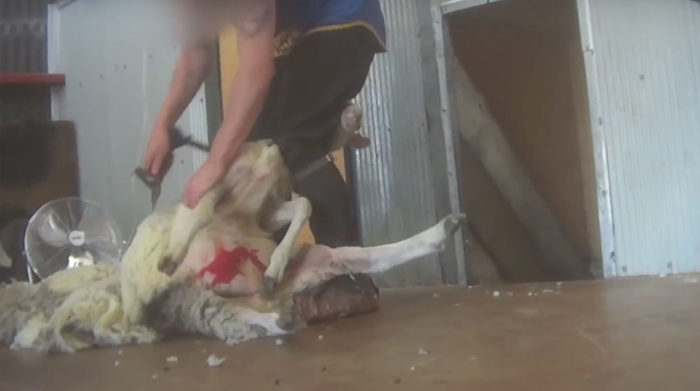
Sheep used, abused and killed in the wool and meat industries deserve better. A vegan world is a world in which this cruelty does not exist. Head to Vegan Easy if you would like to help see that world come sooner!
See our Sheep Truth page for more information.
References:
Dual-Purpose Breeds:
Wool Wise
Australian Wool Innovation and The Woolmark Company
Meat And Livestock Australia
Oxford Dictionary
NZ Agritech
RSPCA p24-25
Slaughter: Lambs
Australian Bureau of Statistics
Aussie Abattoirs
Lamb and Beef Australia
Slaughter: Sheep
Australian Bureau of Statistics
RSPCA
Lamb and Beef Australia
Good Food and Feather and Bone
ZQ Natural Fibres
Meat and Livestock Australia
Live Export
Agriculture, Government
Animals Australia
RSPCA
Winter Lambing
Animal Liberation Victoria
Agriculture, Government of Victoria
ABC
Selective Breeding: Lambing and Mothers
ABC
Agriculture Western Australia
Making More From Sheep
Meat and Livestock Australia
CSIRO
Sheep Genetics
Standard Practice: Tail Docking
Agriculture, Government of Victoria
Flyboss
Agriculture Western Australia
Animal Welfare Standards by Meat and Livestock Australia
Responsible Wool Standard1
Responsible Wool Standard2
Responsible Wool Standard 3
Standard Practice: Castration
Agriculture, Government of Victoria
Animal Welfare Standards by Meat and Livestock Australia
Responsible Wool Standard
Emasculator
A Greener World
Animals Australia
Standard Practice: Mulesing
Agriculture, Government of Victoria
Shearing
Peta
NSW Farming, Growing The Best